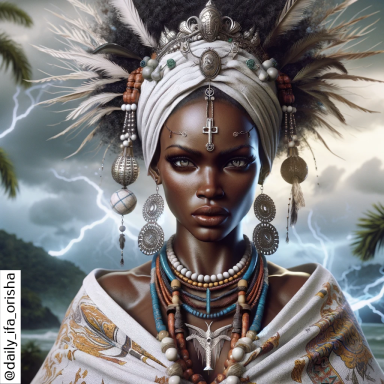
About ORISHÀ OYÁ
Orishá Oyá, also known as Yansan in Brazil, is a powerful deity in the Yoruba religion and its Afro-diasporic offshoots like Candomblé and Santería. She is revered as the goddess of winds, storms, and the Niger River, and is known for her fierce warrior spirit and her role as the guardian of the gateway between life and death. Oyá's diverse roles and characteristics make her a powerful orishá, influencing various aspects of life, from personal transformation and empowerment to spiritual guidance and protection.
About the ORISHÁ
Roles and
Influence
- Goddess of Wind and Storms: Oyá embodies the uncontrollable nature of wind, lightning, and storms.
- Warrior Goddess: She is depicted as a fierce warrior who clears paths and fights enemies, often with a machete.
- Guardian of the Gateway to Death: Oyá is the custodian of cemetery gates, guiding the spirits of the deceased.
- Transformer: She symbolizes change and transition, often associated with upheaval and drastic change.
- Protector of Women: Oyá defends women, using her strength to protect them and fight for their rights.
- Patron of the Marketplace: In some traditions, Oyá is seen as the patroness of the marketplace and commerce.
- Symbol of Female Power and Independence: She represents female power and independence, often breaking traditional gender norms.
- Goddess of the Niger River: Oyá is associated with the turbulent and changing waters of the River Niger.
- Spirit of Dance and Whirlwinds: She embodies the ecstatic movements of dance, likened to the whirlwinds she commands.
- Bearer of Ancestors' Spirits: As a guardian between life and death, Oyá bears the spirits of the ancestors, providing a link between the living and the dead.
Characteristics and Symbolism
- Symbols: Sword, short tail leather scepter with cow or buffalo tail hair.
- Colors: Coral, red, brown, pink.
- Natural Places: Bamboo plantation.
- Flowers: Yellow or coral red flowers.
- Essences: Patchouli.
- Stones: Ruby, terracotta, garnet, coral, carnelian.
- Metal: Copper.
- Planet: Moon and Jupiter.
- Weekday: Wednesday.
- Element: Moving air (wind), fire, red metal.
- Chakra: Third eye and heart.
- Greeting: Èpà heyi!
- Animals/Offerings: Goat, castrated billy goat, duck, rusty dove, guineafowl.
- Plants: Various, including Ocimum basilicum and Sansevieria trifasciata.
- Foods and Drinks: Acarajé (fried bean balls), champagne.
- Number: 9.
- Commemoration Day: December 4th.
- Syncretism: St. Barbara, Joan of Arc.
- Manifestations: Various forms and manifestations.
- Incompatibilities: Pumpkin, sheep, stingray, mouse.
- Title: Mother of the Nine Rooms.
Key Manifestations (Aspects)
Oyá manifests in more than 70 aspects. A few examples:
- Oyá Abomi - This quality is revered in few houses. Associated Orishás: Xangô and Oxum.
- Oyá Afefê - This Oyá is associated with winds and storms. She dresses in white and carries an Adê with an orange "Chorão". Associated Orishás: Omolu and Egum.
- Oyá Afefere - This is the path of the wind that blows according to its whim. It is interpreted as the path in all directions because the goddess controls it and rides on it. For the followers, it represents abundance and the path to open the mind to seek understanding of things.
- Oyá Agangbelê - Oyá in connection with the winds in the trees and leaves. On this path, she refers to the difficulties in relation to the conception of children. Shrine at the foot of an Iroko tree. Associated Orishás: Iroko, Ossaim, and Shangô.
- Oyá Ayawa - On this path, Oyá is a wise and very powerful old woman with gifts of divination and clairvoyance. She is a hermaphrodite with both female and male characteristics. She is an expert in witchcraft and magic and can achieve anything she desires by simply attempting it.
- Oyá Bagan - Oyá warrior, associated with winds and forests. She has no head. She "eats" with Eshu Bará, Ogum, and Odé. She has paths with Egun and Ossaim. Associated Orishás: Odé, Exu Bara, Egun, Ogum, Ossaim.
After becoming a mother (Yansan) she manifests as Igbalé in nine qualities:
- Oyá Igbalé Adagambará - She has a connection to Eshu. She is dressed in white and carries Eruexim. Associated Orishá: Eshu Bara.
- Oyá Igbalé Afakarebó - Rarely worshipped in few Terreiros. She is connected to Exu. Wears white attire and carries Eruexim. Associated Orishá: Eshu.
- Oyá Igbalé Até Oju - Also rarely worshipped. She is connected to Nanã. Wears white attire and carries Erueshim. Associated Orishá: Nanã.
- Oyá Igbalé Egunitá - She is the mistress of the wind in bamboo and is one of the most worshipped Igbalés. She has a deep connection to souls and ancestors. Associated Orishás: Oshalá and Nanã. Also Ogun Waré and Odé.
- Oyá Igbalé Funan (or Fumam) - This Igbalé is more connected to the center of bamboo and is an older Orisha. Associated Orishás: Oshalá and Nanã. Also Ogum, Obaluaye, Iku, Egum.
- Oyá Igbalé Furê (or Tanan) - Aspect of Igbalé that is more related to the transition from life to death. Associated Orishás or realms: Iku, Egun.
- Oyá Igbalé Guerê (or Logunerê) - Rarely worshipped. She has connections to Omolu and Ogum. She is dressed in white and carries Erueshim. Associated Orishás: Omolu and Ogum.
- Oyá Igbalé Padá - Another mistress of the bamboo shoot, connected to leading and protecting the dead. White attire, wears mariwo, and carries Eruexim. Associated Orishás: Oshalá, Nanã, and Omolu.
- Oyá Toningbé (Tonimbé)
Sign-Up for free to your Weekly Newsletter.
Illustrations of the Orishá
Wir benötigen Ihre Zustimmung zum Laden der Übersetzungen
Wir nutzen einen Drittanbieter-Service, um den Inhalt der Website zu übersetzen, der möglicherweise Daten über Ihre Aktivitäten sammelt. Bitte prüfen Sie die Details und akzeptieren Sie den Dienst, um die Übersetzungen zu sehen.




